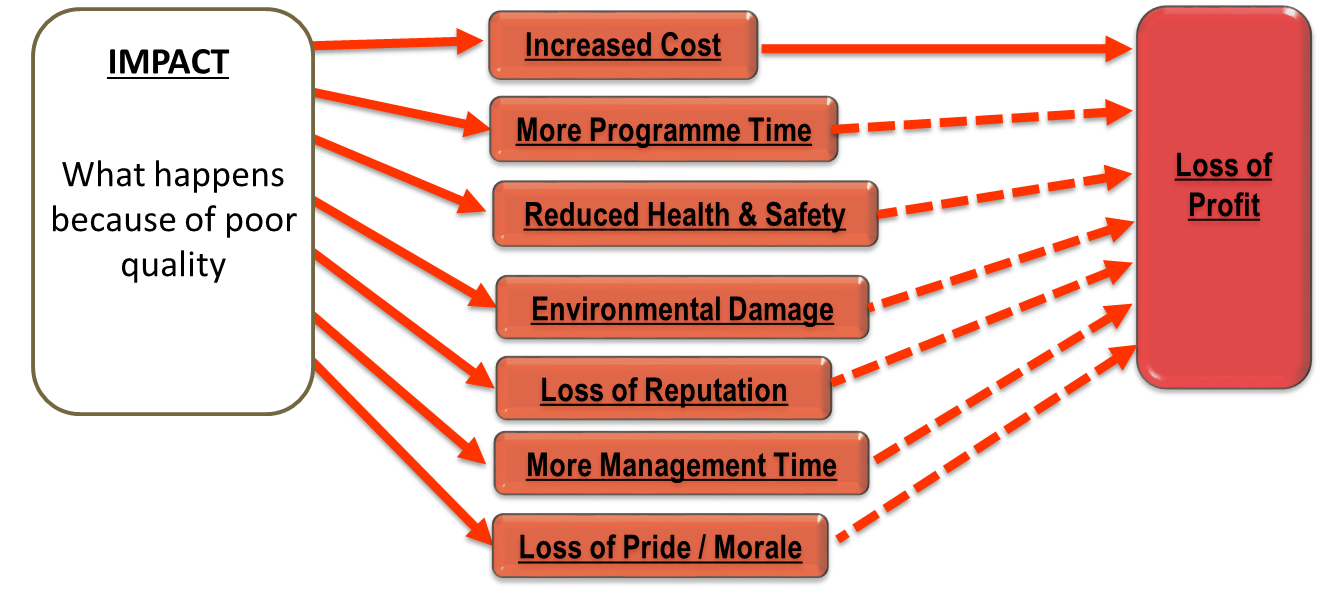Why should quality be important to the construction industry?
Contents |
[edit] Introduction
The well-known 1998 report of the Construction Task Force (chaired by Sir John Egan), Rethinking Construction, identified the Construction Industry as ‘under-achieving’ with ‘low profitability’ and clients ‘dissatisfied with overall performance’. It calls for a radical change to processes and culture to bring about the improvement required. The report also suggests that zero defects across the construction industry is possible within 5 years with a 20% decrease target per annum.
A recent report published by the Construction Industry Council, The Farmer Review of the UK Construction Labour Model, highlights profitability and productivity as ongoing concerns for the Construction Industry. Another recent industry report by the Get It Right Initiative (https://getitright.uk.com/) estimated the cost of error in construction to be £10 – 25bn per annum.
These two recent reports suggest that two decades after Rethinking Construction little change has realised.
One of the key drivers for change identified within Rethinking Construction was a ‘quality driven agenda’.
Quality is gaining greater focus in construction (partly due to recent events). For example, a Joint Memorandum of Understanding was signed March 2018 by representatives from RIBA, CIOB and RICS as part of the ‘Building in Quality’ initiative. This aims to improve quality through improvements to collaboration and procurement and introduction of new methods.
‘Quality’ is still misunderstood. It is necessary to appreciate why quality should be important for construction and the benefits it can bring not only in eliminating defects but the way in which it can help enhance profit and drive improvement. In fact, embracing the concepts of quality could make an invaluable contribution to achieving the objectives outlined in Construction 2025, Industrial Strategy: government and industry in partnership.
[edit] Cost of quality
Often the reason why quality is important is attributed to cost arising from waste. It is true that poor quality can result in significant costs and consequential reduction in profits so is often the factor that gains the attention of senior management.
Cost is certainly an important consideration. However, this focus on cost does not take into account other factors. For example:
- Cost does not focus on the ways in which quality can enhance profit beyond reducing waste.
- Although cost might be important to some people, it might not be a consideration for others. How relevant is a reduction in profit for an operative on site who received a standard wage and is therefore unaffected financially?
- Cost is not the only impact of poor quality.
- Focus on cost can have negative influences. For example, promoting the cost resulting from nonconformity reports may prevent people from seeing them as a positive tool from which learning can be gained and improvements made.
Rather than focussing only on the ‘cost of quality’, there should be a broader focus on the ‘impact’ of quality. Furthermore, ‘impact’ does not only have to be negative. Quality can positively impact the prosperity of a business.
[edit] Quality as an outcome
Quality is an outcome. That outcome may be good or it may be bad.
If a customer eats in a restaurant and receives good service with tasty food, the customer may choose to return instead of visiting another restaurant and may even promote the restaurant to peers creating more custom. In fact, even if the restaurant was more expensive than a competitor the customer may consider better value is offered and be content to pay higher prices.
Conversely, if the customer has a bad experience, that customer is unlikely to return but is likely to inform others who may be put off visiting in the first place. The ‘impact’ of the of the bad experience has not only resulted in loss of profit opportunity but loss of reputation. One ‘impact’ of the good experience could be competitive advantage over other restaurants enhancing profit.
This simple example aims to illustrate the positive impact which quality can have on businesses whilst the negative impacts from poor quality are not only limited to cost.
[edit] Impacts of poor quality
The impact of poor quality in construction is not only the financial cost to the Industry. There are other adverse consequences which may also indirectly affect the profit. Some examples are shown in Figure 1 and explained in more detail below.
 [Figure 1: Examples of impacts of poor quality]
[Figure 1: Examples of impacts of poor quality]
[edit] Health & safety
Very often poor quality and poor health and safety are linked. It is not unusual for a safety incident to be the result of poor quality. For example, if a cladding panel is not adequately secured and falls from a building injuring a member of the public, a safety incident would likely be assumed. However, the safety incident is actually a consequence of a quality issue.
Additionally, if rework is required due to poor quality, those undertaking the work are having to be re-exposed to the risks related to original installation. In fact, in some cases those risks might be greater if works have to be undertaken in a live environment. For example, rework on highways may be undertaken post-handover when the road has been opened to traffic.
This could also bring into play all the moral and legal aspects often associated with why health and safety is important.
Furthermore, it is often recognised that there is a positive correlation between construction sites which have a good level of health and safety and those which have high quality standards.
[edit] Reputation
Poor quality can adversely influence the reputation with the client. This can result in a lack of trust regarding the reliability of the finished product which can add to the challenges of completion and handover.
Loss of reputation might influence the opportunities for repeat business.
[edit] Programme
Poor quality can significantly influence the programme if rework is required. Even if this does not affect the critical path and, hence, overall programme, resource may need to be diverted from other activities or increased to resolve quality issues.
[edit] Environment
Poor quality can often result in the need to replace materials. The materials become waste which must then be removed. Although this will cost extra money, there may also be an impact to the environment if waste is sent to landfill. Furthermore, if additional raw products are required, manufacturing processes must be completed again and goods delivered to site which could adversely influence the carbon footprint. The additional travel of those involved in resolving quality issues adds further to the carbon footprint (as well as the additional time required).
[edit] Management time
Resolving nonconformities can be extremely time consuming for managers. This is often a ‘hidden’ aspect when considering how much a nonconformity has cost. Not only does this increase the pressure on construction personnel who are already often extremely busy but the time managers spend dealing with defects could be much better spent on other activities—perhaps on activities to enhance delivery excellence. In fact, there are many examples where additional management resource has had to be brought in purely to assist with resolving defects or site managers must remain on projects long after completion.
[edit] Pride/Morale
Those working in construction should feel a great sense of pride in the achievements from completing a construction project or an element of the works. This can be a key motivation factor for those at the work face. However, observing work being damaged by a lack of care/protection or demolished because the design was wrong can be extremely demoralising.
[edit] Enhancing Profit
Therefore, further to the above, very often the focus is achieving a situation where we reduce the ‘waste’ (Figure 2). This, of course, is certainly a desirable outcome.
[Figure 2: Reducing waste from poor quality]
However, quality should not only be concerned with meeting the specification requirements. Quality is also about delivering with excellence. Taking the earlier example of the restaurant, it is this approach which can lead to competitive advantage and enhanced profit (Figure 3).
 [Figure 3: Focus on excellence to enhance profit]
[Figure 3: Focus on excellence to enhance profit]
Therefore, a key question is how might not only the negative impacts of poor quality be mitigated but how can quality also be used to positively impact (enhance) profit?
There are two key areas to consider regarding quality:
Firstly, quality management can offer the governance framework and a structured approach to ensure that:
- requirements are achieved right first time
- mechanisms are in place to provide confidence that the correct outcome has been achieved.
Secondly, quality management offers many tools and techniques which can enhance delivery to create ‘excellence’ by improving:
- what is delivered to the customer
- the way the product and / or service delivery is achieved (i.e. improved delivery solutions)
[edit] Creating Excellence
How, therefore might quality benefit construction organisations to achieve excellence through quality and improve profit further? The following outlines some examples:
- Quality initiatives can improve the way processes are delivered reducing time and cost. This can allow organisations to offer clients solutions which are cheaper and handed over in shorter timeframe as well as meeting the specification requirements. This can create competitive advantage and provide increased profit. The use of offsite manufacture and lean techniques are typical examples.
- Quality can be used to find better ways to meet the needs of the customer. Car manufacturers and mobile phone providers are typical examples of organisations who are always striving to better their offering to the customer to improve competitive advantage.
- Quality can increase the reputation of an organisation. It can create a business ‘brand’ which customers associate with ‘quality’. For example, there a certain brands of tools which construction professionals automatically associate as higher quality. Where these brands are considered to offer better quality, not only are the products / services desirable but the customer is often willing to pay more. Construction organisation creating themselves a ‘brand’ with a reputation for delivering quality will certain be more desirable for clients who may even be willing to pay more.
- Working for an organisation which has a ‘quality culture’ has been proven to increase employee satisfaction which in turn can help reduce staff turnover and increase productivity.
- Quality initiatives will involve a collaborative approach with the relevant people (employees and customers), contractors, designers, suppliers, and third parties to achieve the best improvement opportunities. This helps to utilise the knowledge and experience from all aspects of the business to bring about the best improvement.
One of the key advantages of a quality culture is that it will always strive for better. Competitive advantage will only last for so long before similar organisations copy (or even better) the ideas. It is therefore necessary for organisations wanting to sustain excellence to continually change, adapt and improve.
In fact, it has been demonstrated many times that those that don’t change cease to exist. Blockbuster is a typical example. In not adapting to the changing customer requirement for on demand entertainment at home, its business model ceased to be appealing to customers.
[edit] Benefits
Benefits resulting from quality focus could be as those which we can physically touch (e.g. money) and those which we can’t (e.g. customer satisfaction)--i.e. ‘tangible’ and ‘intangible’ benefits. Furthermore, benefits may be directly achieved or indirectly achieved. For example, saving ‘time’ through improving quality may indirectly benefit profit.
Additionally, one aspects which can make it extremely challenging to justify the benefits of quality management is that benefits can be unknown. By establishing a quality management system, an incident which could have occurred may be prevented. However, as the incident never occurred, no one will even know that was a benefit!
For example, if an Inspection and Test Plan (ITP) is established to help control the quality of the works and prevents an issue from occurring, it is likely the benefit of creating that ITP will never be known because there was no adverse impact. Furthermore, the construction industry is well known for not effectively sharing best practice and thus many of the benefits from quality initiatives from individual projects and organisations are not communicated.
These benefits are represented in the Venn diagram in Figure 4.
[Figure 4: Classification of the Benefits of Quality]
[edit] External references
Construction Industry Council (October, 2016) The Farmer Review of the UK Construction Labour Model: Modernise or Die: Time to decide the industry’s future. Available from: http://www.constructionleadershipcouncil.co.uk/wp-content/uploads/2016/10/Farmer-Review.pdf [9/3/18]
Egan, J. (1998) Rethinking construction: report of the construction task force on the scope for improving the quality and efficiency of UK construction. Department of the Environment, Transport and the Regions, London. Available from:
http://constructingexcellence.org.uk/wp-content/uploads/2014/10/rethinking_construction_report.pdf [9/3/18]
Get It Right Initiative (April, 2016) Improving value by eliminating error. Available from: https://getitright.uk.com/reports/research-report [21/09/2020]
H M Government (July, 2013) Construction 2025, Industrial Strategy: government and industry in partnership. Available from:
Original article written by Mike Buss, reviewed by Jon Adshead and Karen McDonald on behalf of the Chartered Quality Institute, Construction Special Interest Group, and accepted for publication by the Competency Working Group on 07 March 2018.
--ConSIG CWG 13:33, 05 Jan 2019 (BST)
[edit] Related articles on Designing Buildings
- Design freeze: a quality perspective.
- Failure modes and effect analysis (FMEA).
- Inspection and test plan.
- How to write an inspection and test plan.
- Change control: a quality perspective.
- Mobilisation to site: a quality perspective.
- Structural steelwork: a quality perspective.
- Lifts and escalators: a quality perspective.
- Quality culture and behaviours.
Featured articles and news
Infrastructure that connect the physical and digital domains.
Harnessing robotics and AI in challenging environments
The key to nuclear decommissioning and fusion engineering.
BSRIA announces Lisa Ashworth as new CEO
Tasked with furthering BSRIA’s impressive growth ambitions.
Public buildings get half a million energy efficiency boost
£557 million to switch to cleaner heating and save on energy.
CIOB launches pre-election manifesto
Outlining potential future policies for the next government.
Grenfell Tower Inquiry announcement
Phase 2 hearings come to a close and the final report due in September.
Progress from Parts L, F and O: A whitepaper, one year on.
A replicated study to understand the opinion of practitioners.
ECA announces new president 2024
Electrical engineer and business leader Stuart Smith.
A distinct type of countryside that should be celebrated.
Should Part O be extended to existing buildings?
EAC brands heatwave adaptation a missed opportunity.
Definition of Statutory in workplace and facilities management
Established by IWFM, BESA, CIBSE and BSRIA.
Tackling the transition from traditional heating systems
59% lack the necessary information and confidence to switch.
The general election and the construction industry
As PM, Rishi Sunak announces July 4 date for an election.
Eco apprenticeships continue help grow green workforce
A year after being recognised at the King's coronation.
Permitted development rights for agricultural buildings
The changes coming into effect as of May 21, 2024.

























Comments
Hi, Im from Peru, and here the quality in construction it has very narrow limits because its only focus on prevent NCR. If one project has less NCR than other one, thats a good project. We are not in the next level of quality where we are concern about management or intagible benefits.
Its that normal?
Sadly, that can be the case. It is very easy to count the cost of NCRs and rework after the event and much more difficult to predict what could be saved if the risks are predicted, assessed and managed with a view to preventing the NCRs from occurring in the first place. Of course, implementing a rigorous Quality Management System, particulary if it satsifies one of the International Standards such as ISO 9001, will go a long way towards changing behaviours and attitudes towards working in a safe way to construct a project that will be to standard and design and will be safe for the people who will inhabit it..
I hope this answers your question. Please feel free to carry this conversation on.
Best regards,
Keith Hamlyn B.Ed(Physics), CQP, FCQI, MICW.
If ISO 9001 was the answer for construction, then clearly it hasn't worked!
Steve S